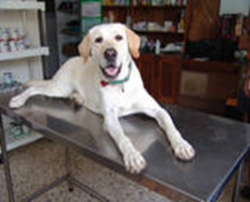The contents of this page are general advice only. Please consult your veterinarian if you have any questions or suspect something may be wrong with your dog.
What does a healthy dog look like?
A healthy dog has a shiny coat, bright eyes and enough energy and enthusiasm to keep up with the demands of being a companion and competitor. Health includes genetic health, physical health and mental health. Read on for information on keeping your dog healthy and caring for it when it is not.
Sick as a dog
When people get sick, they can tell the doctor how they feel. What happens when your dog gets sick? Your dog can’t talk, so it’s up to you to know when he needs veterinary attention.
 |
The best way to start is to be an observant dog owner. Watch how your dog acts when it feels fine. Any obvious change in your dog’s behaviour is usually a sign that something may be wrong. If a dog that usually bolts down it’s food is suddenly leaving their dinner unfinished, it could be ill Aside from loss of appetite, an owner should watch for: diarrhoea, constipation, excessive drooling or drinking, depression, sudden aggression, difficulty breathing, restlessness, lameness, |
swelling or tenderness, vomiting, fever, runny nose, gummy eyes, coughing or sneezing. All can be symptoms of illness.
If no obvious reason can explain a change in your pet’s behaviour, and the condition does not improve in a day or two, call your local vet. Symptoms that may seem insignificant can hide serious illnesses. Proper diagnosis and treatment from a vet will give your dog the best chance of a complete recovery.
Dental care
Dental care helps keep your dog in top form. Your dog depends on you to help him stay healthy. Good dental hygiene can play an important role in keeping your dog in top form. Clean your dog’s teeth and check his gums regularly.
Healthy gums are firm and pink, black, or spotted. Young dogs have smooth white teeth that tend to darken with age. Puppies have 23 baby teeth, and adults have around 42 permanent teeth, depending on the breed. As adult teeth come in, they push baby teeth out of the mouth.
To check your dog’s mouth, talk to him gently, then put your hand over the muzzle and lift up the sides of his mouth. Check that adult teeth are coming in as they should, and are not being crowded by baby teeth. Look for soft white matter or hard white, yellow, or brown matter on the teeth. This is plaque or tartar and should be brushed away. Make sure your dogs gums are healthy and his breath is not foul-smelling. Mouth infections can lead to serious problems in the gums and other parts of the body, including the heart, so it’s important to give your dog’s teeth and mouth special attention.
Clean your dog’s teeth frequently with special toothbrushes and toothpaste designed for dogs. If your dog balks at having his teeth brushed, get him used to it by rubbing his teeth and gums with your finger. Then put a little of the toothpaste on your finger and let him sniff and lick it; do the same with the toothbrush. Make sure to provide chew toys or other products that will help clean his teeth. As your dog gets older, he may have a buildup of tartar that requires special cleaning by a veterinarian.
Preventative Care
Dogs are hardy animals but require a few precautions to ensure they remain healthy.
Vaccination
When you purchase your dog ask for its vaccination certificate which will be signed by a veterinarian. If your dog or puppy has had no previous vaccinations or if you are unsure whether it has been vaccinated, you should take it to your veterinarian to receive a health check and vaccinations for Canine Distemper, Viral Hepatitis, Parvo Virus and Kennel Cough. Puppies require the first vaccinations between 6 – 8 weeks with the second at 12 – 16 weeks old. All dogs require a ‘booster’ vaccination every 12 months.
Worming
Dogs need to be wormed regularly to control roundworms, hookworms and tapeworms which live in the intestine. This is easily done by using one of the many available preparations, either as tablets or liquids. All dogs should be wormed every three months, although puppies must be done more frequently. Follow the instructions on the preparations or consult your veterinarian.
Heartworm is transmitted by mosquitoes, is present in many areas of Australia and can be fatal. There are several preventative products now available including daily or monthly tablets. All dogs other than very young puppies must be tested by a veterinarian before starting a heartworm prevention program as the medication can be fatal to dogs already infected.
Fleas and Ticks
Fleas and ticks are often a problem during the warmer months. Adult fleas present on the dog may be killed using sprays, powders, rinses or flea collars, but is necessary to treat other pets and also the environment, especially the dog’s bedding. Precautions and directions on the packaging of the flea control products must be followed exactly.
Paralysis ticks occur in some areas of Australia and can be fatal to dogs. If you live in an area where there are paralysis ticks you should check your dog daily and remove any ticks. If a tick is found consult your veterinarian. Tick Identification Chart

